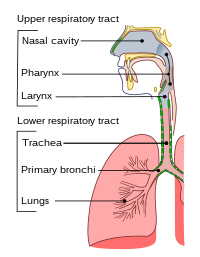
Photo from wikipedia
Significance All respiratory viruses, including human coronaviruses (HCoVs), enter and establish a primary infection in the nasal epithelium. Primary nasal epithelial cells cultured at air–liquid interface (ALI) closely resemble the… Click to show full abstract
Significance All respiratory viruses, including human coronaviruses (HCoVs), enter and establish a primary infection in the nasal epithelium. Primary nasal epithelial cells cultured at air–liquid interface (ALI) closely resemble the in vivo nasal epithelium and thus are an optimal system in which to query HCoV–host interactions. We use human nasal ALI cultures to differentiate among lethal (SARS-CoV-2 and MERS-CoV) and seasonal (HCoV-NL63 and HCoV-229E) HCoVs in terms of replication, cellular tropism, and cytotoxicity induction during infection. We further differentiate among these HCoVs using IL-13 treatment to recapitulate an asthmatic or inflamed airway and find that pre-existing disease states can significantly impact HCoV replication. HCoV–host interactions in the nasal epithelium are likely to determine clinical outcomes such as disease severity and transmissibility.
Journal Title: Proceedings of the National Academy of Sciences of the United States of America
Year Published: 2023
Link to full text (if available)
Share on Social Media: Sign Up to like & get
recommendations!